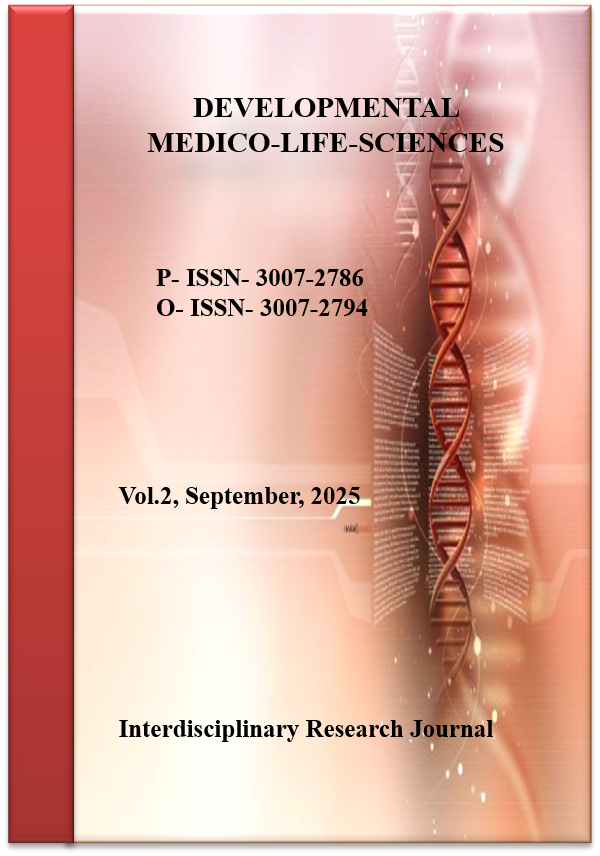Predictors of Mortality in Patients Hospitalized with Community-Acquired Pneumonia: A Retrospective Analysis
Identifying Prognostic Indicators for CAP Mortality
DOI:
https://doi.org/10.69750/dmls.02.09.0157Keywords:
Community-acquired pneumonia, mortality predictors, CURB-65 score, chronic kidney disease, Pakistan, retrospective analysisAbstract
Background: Community-acquired pneumonia (CAP) remains a major cause of morbidity and mortality worldwide, particularly in low- and middle-income countries. Identifying predictors of poor outcomes is essential to optimize early management and reduce mortality.
Objective: To determine the clinical, laboratory, and radiological predictors of in-hospital mortality among patients hospitalized with CAP in a tertiary-care hospital in Pakistan.
Methods: A retrospective observational study was conducted at the Department of Medicine, Nishtar Medical University and Hospital, Multan, from June 2024 to May 2025. Medical records of 100 adult CAP patients were reviewed. Demographic, clinical, and biochemical variables were analyzed. Disease severity was assessed using the CURB-65 score. Univariate and multivariate logistic regression analyses were performed to identify independent predictors of mortality.
Results: The mean age of patients was 59.3 ± 15.7 years; 62% were male. Overall in-hospital mortality was 21%. Factors significantly associated with mortality included age ≥ 65 years, diabetes, COPD, chronic kidney disease (CKD), tachypnea, hypotension, altered consciousness, raised urea and creatinine, hyponatremia, multilobar infiltrates, and high CURB-65 scores. Multivariate analysis identified four independent predictors: age ≥ 65 years (AOR 5.21, p = 0.021), CKD (AOR 4.92, p = 0.035), hypotension (AOR 4.37, p = 0.046), and CURB-65 ≥ 3 (AOR 6.45, p = 0.013).
Conclusion: Advanced age, renal dysfunction, hypotension, and high CURB-65 scores independently predict mortality in CAP. Early identification and aggressive management of high-risk patients can improve outcomes in resource-limited settings.
Downloads
References
Metlay JP, Waterer GW, Long AC, Anzueto A, Brozek J, Crothers K, et al. Diagnosis and treatment of adults with community-acquired pneumonia: an official clinical practice guideline of the American Thoracic Society and Infectious Diseases Society of America. Am J Respir Crit Care Med. 2019;200(7):e45-e67. doi:10.1164/rccm.201908-1581ST
Lim WS, van der Eerden MM, Laing R, Boersma WG, Karalus N, Town GI, et al. Defining community acquired pneumonia severity on presentation to hospital: an international derivation and validation study. Thorax. 2003;58(5):377-82. doi:10.1136/thorax.58.5.377
Fine MJ, Auble TE, Yealy DM, Hanusa BH, Weissfeld LA, Singer DE, et al. A prediction rule to identify low-risk patients with community-acquired pneumonia. N Engl J Med. 1997;336(4):243-50. doi:10.1056/NEJM199701233360402
Torres A, Cilloniz C, Niederman MS, Menendez R, Chalmers JD, Wunderink RG, et al. Pneumonia. Nat Rev Dis Primers. 2021;7(1):25. doi:10.1038/s41572-021-00267-3
Restrepo MI, Sibila O, Anzueto A. Community-acquired pneumonia in adults: update 2023. Am J Respir Crit Care Med. 2023;208(5):501-14. doi:10.1164/rccm.202302-0308UP
Jain S, Self WH, Wunderink RG, Fakhran S, Balk R, Bramley AM, et al. Community-acquired pneumonia requiring hospitalization among U.S. adults. N Engl J Med. 2015;373(5):415-27. doi:10.1056/NEJMoa1500245
Cilloniz C, Ward L, Mogensen ML, Pericàs JM, Méndez R, Gabarrús A, et al. A machine-learning model for mortality prediction in community-acquired pneumonia outperforms traditional risk scores. Chest. 2023;163(1):77-88. doi:10.1016/j.chest.2022.07.031
Kaal AG, Op de Hoek L, Hochheimer DT, Brouwers C, Wiersinga WJ, Snijders D, et al. Outcomes of community-acquired pneumonia using the Pneumonia Severity Index versus CURB-65 in emergency department patients. ERJ Open Res. 2023;9(3):00051-2023. doi:10.1183/23120541.00051-2023
Lüthi-Corridori G, Boesing M, Roth A, Giezendanner S, Leuppi-Taegtmeyer AB, Schuetz P, et al. Predictors of length of stay, rehospitalization and mortality in community-acquired pneumonia: a retrospective cohort study. J Clin Med. 2023;12(17):5601. doi:10.3390/jcm12175601
Bahlis LF, Diogo LP, Fuchs SC. Charlson Comorbidity Index and other predictors of in-hospital mortality among adults with community-acquired pneumonia. J Bras Pneumol. 2021;47:e20200257. doi:10.36416/1806-3756/e20200257
Zhao L, Bao J, Shang Y, Zhang Y, Yin L, Yu Y, et al. The prognostic value of serum albumin levels and respiratory rate for community-acquired pneumonia: a prospective, multi-center study. PLoS One. 2021;16(3):e0248002. doi:10.1371/journal.pone.0248002
Zhang J, Liu J, Wei H, He L, Chen X, Yu H, et al. Enhancing pneumonia prognosis in the emergency department: comparing CURB-65 score versus Cox regression model. BMC Med Inform Decis Mak. 2024;24(1):125. doi:10.1186/s12911-024-02523-1
Tuta-Quintero E, Gómez F, Hernández M, Botero Y, López E, Rojas A, et al. Comparison of performances between risk scores for predicting 30-day mortality in adult community-acquired pneumonia patients. BMC Infect Dis. 2024;24:317. doi:10.1186/s12879-024-09792-1
Benhamed L, Kacem R, Maamri T, Hentati H, Chatti S, Slim A, et al. The battle of the pneumonia predictors: a comprehensive meta-analysis comparing the PSI and CURB-65 score in predicting mortality and the need for ICU support. Cureus. 2023;15(5):e170716. doi:10.7759/cureus.170716
Martín-Loeches I, Torres A, Nagavci B, Aliberti S, Antonelli M, Bassetti M, et al. ERS/ESICM/ESCMID/ALAT guidelines for the management of severe community-acquired pneumonia. Intensive Care Med. 2023;49(6):615-32. doi:10.1007/s00134-023-07161-z
Chalmers JD, Campling J, Ellsbury G, Hawkey PM, Madhava H, Slack M. Community-acquired pneumonia in older adults: clinical outcomes and predictors of mortality. J Infect. 2020;80(5):577-86. doi:10.1016/j.jinf.2020.02.003
Uranga A, España PP, Bilbao A, Quintana JM, Arriaga I, Intxausti M, et al. Predicting 1-year mortality after hospitalization for community-acquired pneumonia. PLoS One. 2018;13(8):e0192750. doi:10.1371/journal.pone.0192750
Kuipers S, Cals JWL, Chavannes NH, Croonen BH, Smeets M, van de Leur H, et al. NEWS2 vs CURB-65/PSI for predicting outcomes in community-acquired pneumonia: a multicentre emergency department cohort. Am J Emerg Med. 2022;57:14-21. doi:10.1016/j.ajem.2022.04.033
Aliberti S, Amati F, Pappalettera M, Blasi F. Management of severe community-acquired pneumonia in the ICU: risk factors and outcomes. Curr Opin Crit Care. 2021;27(5):460-8. doi:10.1097/MCC.0000000000000860
Musher DM, Thorner AR. Community-acquired pneumonia. N Engl J Med. 2014;371(17):1619-28. doi:10.1056/NEJMra1312885
Jain S, Zelaya C, Puing-Arenas A, Braykov NP, Newland JG, Ambroggio L, et al. Performance of severity scores to predict mortality in hospitalized adults with CAP: a systematic review and meta-analysis. Clin Microbiol Infect. 2020;26(8):939-46. doi:10.1016/j.cmi.2020.02.024
Jones BE, Jones J, Bewick T, Lim WS. CURB-65 and mortality prediction in CAP: what have we learned since its introduction? Clin Med (Lond). 2019;19(5):386-9. doi:10.7861/clinmed.2019-0276
Charles PG, Wolfe R, Whitby M, Fine MJ, Fuller AJ, Stirling R, et al. SMART-COP: a tool for predicting the need for intensive respiratory or vasopressor support in community-acquired pneumonia. Clin Infect Dis. 2008;47(3):375-84. doi:10.1086/589753
Aujesky D, Fine MJ. The pneumonia severity index: a decade after the initial derivation and validation. Clin Chest Med. 2005;26(1):41-50. doi:10.1016/j.ccm.2004.10.004
Griffin CL, Bilton D, McKeever TM, Fogarty AW, Jones AM. Multilobar chest radiograph involvement as an independent predictor of severity and mortality in community-acquired pneumonia. Eur Respir J. 2016;48(1):257-9. doi:10.1183/13993003.01862-2015






















